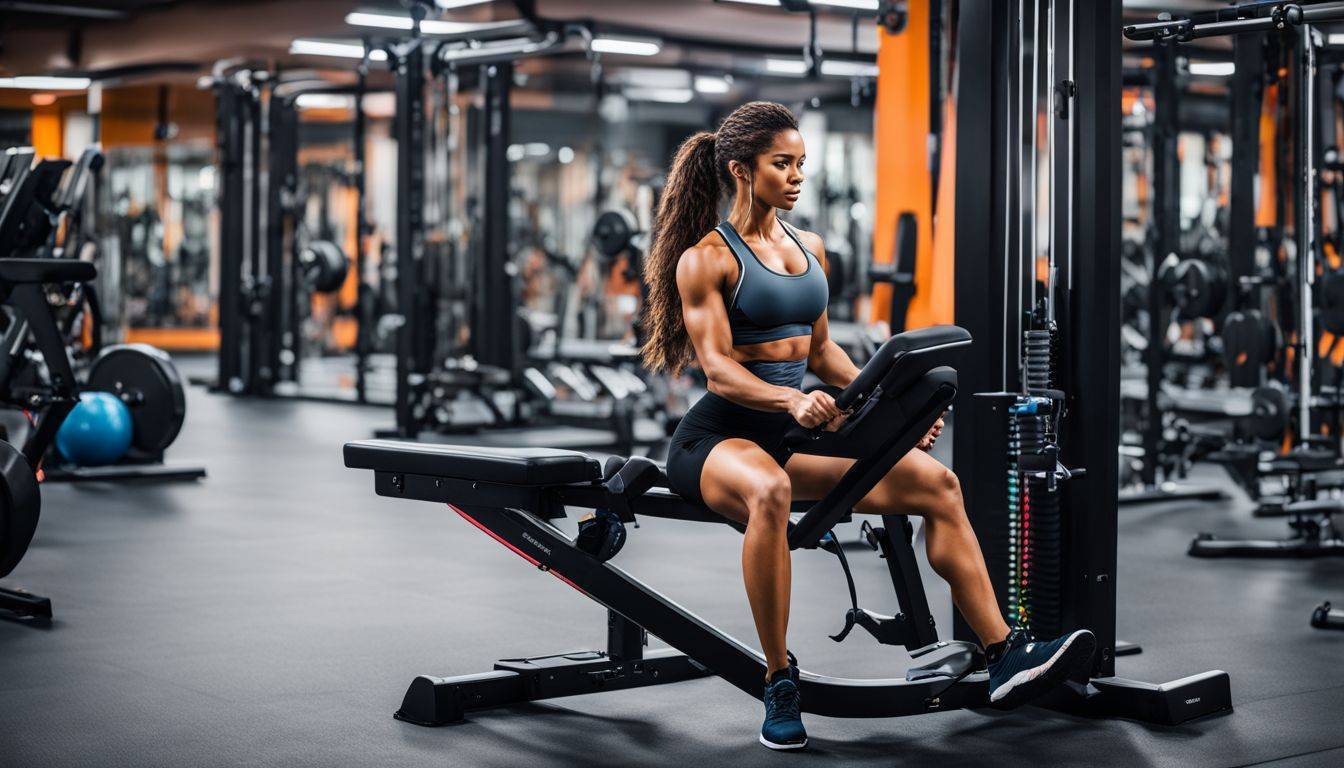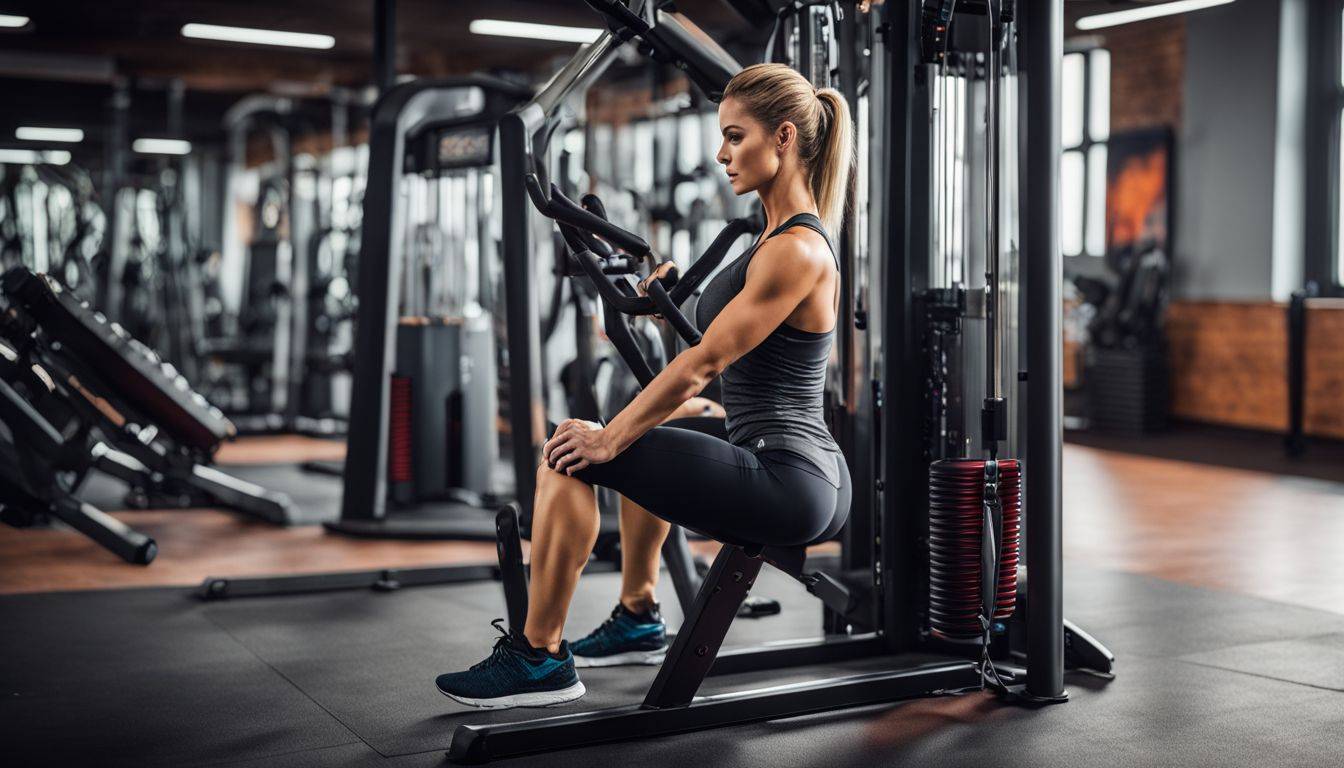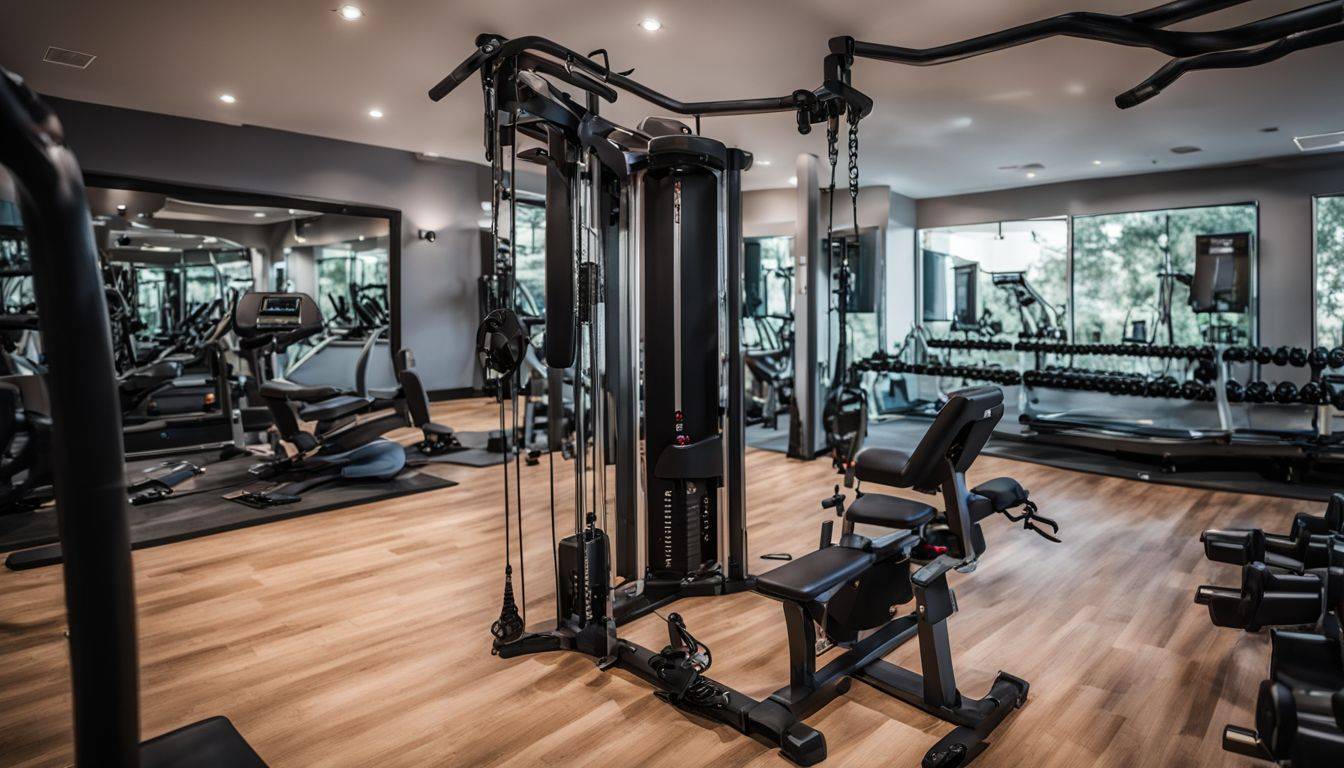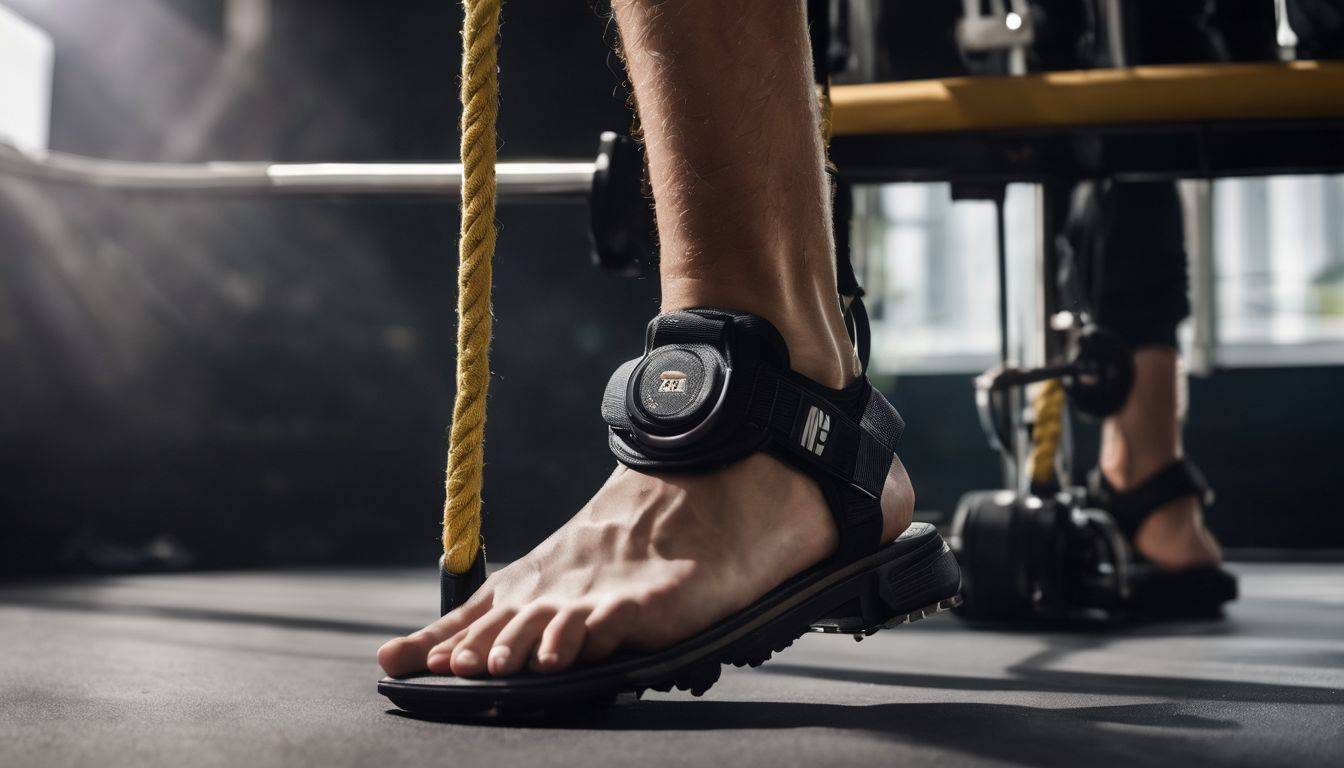Cable glute kickbacks are a great exercise for your backside. They work well to make your glutes strong. In this guide, we will talk about how to do cable glute kickbacks the right way.
Fitness trainer Emily Skye says doing these moves right is very important. If you use too much weight or bend your back wrong, it can hurt rather than help. You should start with less weight and focus on how it feels when you squeeze your muscles.
This workout is special because it works each leg alone. This means both sides of your body get strong in the same way. The best part is that these moves work the big muscle in your bum better than squats do!
We have a lot of tips for doing cable glute kickbacks better as you get stronger at them. Plus, we’ll show other workouts you can try besides just kickbacks!
Now let’s jump into learning all about cable glute kickbacks!
Understanding the Cable Glute Kickback

The Cable Glute Kickback is a move where you use a cable machine to work your butt muscles. You clip one ankle into the cable, stand facing the machine, and push your foot back against the weight.
This targets your gluteus maximus, which is the big muscle in your butt. It helps make this muscle stronger and can give your butt a lifted look.
This exercise also hits other parts of your lower body like your hips and core muscles. While you kick back, these areas work to keep you stable. It’s different from squats or lunges because it works each leg by itself.
This means if one leg is weaker, it gets just as much workout as the stronger leg. Doing exercises like this makes sure both legs are strong and balanced.
Muscles Targeted by the Cable Glute Kickback

After getting to know what a cable glute kickback is, let’s talk about which muscles it works. This exercise is great for the butt, especially the biggest muscle there called the gluteus maximus.
It also helps shape up your hips by working on a muscle known as the gluteus medius. When you do this move, these muscles push your leg back and make them stronger.
You’re not just working out your butt though. Kickbacks also hit other areas like your hamstrings, which are at the back of your thighs. Plus, they help with core strength because you have to keep balance while moving your leg back with weight on it.
So not only are you making your behind look good but also getting a strong backside that can support lots of different moves!
Benefits of Cable Glute Kickbacks

Embracing cable glute kickbacks can transform your workout regimen, offering exceptional benefits such as enhanced muscle definition and boosted athletic performance—discover how this powerhouse exercise can elevate your fitness journey.
Isolates Each Leg Separately
Working each leg on its own is a big plus of cable glute kickbacks. This focus helps make sure both legs get strong in the same way. If one side is weaker, it can catch up and match the other side’s strength.
This kind of training is called unilateral training and it’s great for fixing imbalances.
Using lighter weights at first lets you nail down your form without hurting yourself. As you get better, you can add more weight. This way, you build a strong base for your glute muscles to grow from each single-leg effort.
It makes sure you get the best muscle activation every time you exercise.
Improves Overall Fitness Performance
Doing cable glute kickbacks the right way helps your whole body get better at sports and workouts. You need to activate your glute muscles without letting your back curve. This makes you stronger and keeps your form good when you do other exercises like squats, deadlifts, and hip thrusts.
Also, starting with light weights can help you learn the exercise well. Then, as you get better, you can lift heavier weights safely.
Using both legs one by one makes sure each side of your body works just as hard. It stops one leg from getting stronger than the other. When your legs are even in strength, you move better in all kinds of activities.
Plus, strong glutes support a healthy lower back and pelvis area which lets you do more things without hurting yourself.
Step-by-Step Guide to Perform Cable Glute Kickbacks

Mastering the cable glute kickback can shape your butt and boost strength. Here’s how to do it right.
- Attach a cable ankle strap around your lower leg, just above your ankle.
- Pick a weight that feels light so you can focus on form.
- Stand facing the cable machine with your feet hip – width apart.
- Grab onto the machine or handle for balance.
- Keep your back flat and bend slightly forward at the hips.
- Brace your core tight like you’re ready to take a punch.
- Kick one leg straight back smoothly, keep toes pointed down.
- Make sure only your leg moves, not your whole body.
- Squeeze your butt tight when your leg is fully back.
- Slowly bring the leg back to starting spot without resting it down.
- Do all reps on one side before switching legs.
Common Mistakes While Performing Glute Kickbacks
Doing glute kickbacks the right way helps make your butt muscles stronger. But, some common mistakes can keep you from getting the best results.
- Using too much weight: It’s tempting to lift heavy to grow your muscles fast. Yet, for glute kickbacks, too much weight can ruin your form and hurt you. Start light, and only add weight when you can do the move right.
- Letting your back curve: Keep your back straight during this exercise. A curved back can cause lower back pain and won’t work your butt as it should.
- Moving too fast: Slow and steady wins the race with glute kickbacks. Rushing through reps means less muscle work and more chance for mistakes.
- Forgetting to squeeze: At the top of each kickback, you need to squeeze your butt muscles hard. This squeeze makes sure those muscles are working a lot.
- Skipping full range of motion: Don’t cut the move short! Go all the way through the motion so that every part of your butt muscle gets worked out.
- Standing wrong: Your standing position matters a ton. Stand tall, bend slightly at the knees, and keep stable so you don’t sway side or front to back.
Modifications in Cable Glute Kickbacks
Modifying cable glute kickbacks helps match your fitness level and goals. You can change this exercise to make it easier or harder.
- Use lighter weights: If you’re new to the exercise, start with a light weight to learn the move without strain.
- Increase weight slowly: As you get stronger, add more weight in small amounts to keep challenging your muscles.
- Adjust the pulley height: Set the cable at a lower position for less tension or higher for more challenge.
- Change ankle straps: Try different straps or cuffs for comfort and better control of the movement.
- Stand on a platform: Use a step or box to stand on. This gives you a greater range of motion during the kickback.
- Alter stance position: Stand closer to the machine for less resistance, further away to increase it.
- Switch legs faster: For more intensity, do repetitions quickly but with control, moving from one leg to the other without stopping.
- Add pauses at peak contraction: Hold your leg back for a few seconds when it’s fully extended to work your glutes harder.
- Introduce pulses at the top of the movement: At full extension, do small up and down movements (pulses) before returning your foot back down.
Progression in Cable Glute Kickbacks
After learning how to modify cable glute kickbacks, let’s focus on how you can make them harder over time. You want to keep challenging your muscles to grow stronger.
- Start with lighter weights. This lets you learn the move without hurting yourself.
- Gradually increase the weight. As you get better, add more weight bit by bit.
- Use a higher cable setting. This makes your glutes work harder at a different angle.
- Slow down each rep. Take more time to lift and lower your leg to make it tougher.
- Add more reps or sets. Doing more can build strength and endurance in your glutes.
- Try single – leg sets. Do all reps on one leg before switching to the other leg for a bigger challenge.
- Switch up foot positions. Pointing your toes differently can work new parts of your glutes.
- Hold a peak contraction. Pause at the top of the kickback and squeeze your glutes tight for a few seconds.
- Limit rest time between sets. Take shorter breaks to make your workout more intense.
- Include drop sets or supersets. After doing kickbacks with heavy weight, switch right away to a lighter one without resting or do another exercise right after.
Variations of the Cable Glute Kickback
9. Variations of the Cable Glute Kickback:.
Exploring variations of the cable glute kickback allows for a versatile workout that can be tailored to fitness levels and available equipment, maintaining engagement and preventing plateau.
These alternatives enhance muscle engagement and ensure continuous challenge as your strength and technique evolve.
Resistance Band Glute Kickbacks
You can also try resistance band glute kickbacks to work your butt muscles. For this, you’ll need a resistance band. First, loop the band around one ankle and secure the other end under your foot or to a sturdy object near the ground.
Stand up straight, hold on to something for balance if needed, and make sure that your core is tight. Now, kick one leg back as far as you can without moving your upper body too much.
Squeeze your glute muscle when you do this. Then bring the leg back down slowly.
Doing these steps right makes sure that only your glutes are doing the work which helps them grow stronger over time. This exercise will not only make those muscles better but also help with doing other lower-body moves well.
Keep kicking back smoothly and remember not to let go of squeezing those muscles each time!
Bodyweight Glute Kickbacks
Bodyweight glute kickbacks are a simple exercise to work your butt muscles. You don’t need any weights or machines for this move. Start on your hands and knees. Lift one leg behind you, keeping it straight.
Squeeze your butt as you do this and hold for a moment before bringing the leg back down. Keep your back flat and try not to let your hips twist.
Switch legs after each set of lifts, so both sides get worked evenly. This move helps make your glutes stronger and can lead to better balance in other workouts too. It’s great for beginners since it uses just your body weight and teaches good form from the start.
Alternative Exercises to Cable Glute Kickbacks
Cable glute kickbacks are great for your butt, but there are other exercises you can do too. These moves help you work the same muscles in different ways.
- Try hip thrusts: Sit by a bench and put a barbell over your legs. Lean against the bench so it touches your back below your shoulder blades. Bend your knees and push your hips up, lifting the barbell.
- Use a glute kickback machine: This machine helps you do kickbacks. Stand in front of it, place your foot on the pad, and push back.
- Go for squats: Stand with feet apart and bend down like you’re sitting on a chair. Keep your chest up.
- Do lunges: Step forward with one leg and lower yourself until both knees are bent at 90 degrees.
- Practice deadlifts: Stand with feet hip-width apart, hold a barbell with both hands in front of you, then bend at the hips to lower it down and stand back up.
- Work with resistance bands: Put a band around your ankles or thighs and walk sideways or backward to feel it in your glutes.
- Attempt leg presses: Sit in a leg press machine, place your feet on the platform, and push away until your legs are straight.
- Perform Bulgarian split squats: Place one foot behind you on a bench and squat down with the other leg.
- Test single-leg bridges: Lie on your back with one leg lifted towards the sky; lift your hips off the ground using only one leg.
- Do step-ups: Find a step or bench, place one foot on it, and push yourself up until that leg is straight.
Incorporating Cable Glute Kickbacks into Your Fitness Routine
To add cable glute kickbacks to your workouts, begin with them on leg days. Do other exercises like squats and lunges first, then move on to the kickbacks. These will target your butt muscles when they are already warm.
Start light and focus on doing them right before adding more weight.
Kickbacks should be a regular part of your exercise routine for a strong rear end. They help build muscle in your glutes which can make everyday actions easier like climbing stairs or getting up from a chair.
After mastering cable glute kickbacks, try different types next.
Conclusion
Mastering the cable glute kickback can really shape your butt. It makes your muscles strong and helps with other workouts too. Doing it right means better balance and stronger legs.
If you need more help, look for videos or ask a trainer. Remember to start light and keep your form sharp. Get going and feel the power in your kickbacks!
FAQs
1. What muscles do the cable glute kickback work?
The cable glute kickback targets your gluteal muscles, mainly the gluteus maximus, and also works your minimus to some extent.
2. Is the cable glute kickback better than other butt exercises?
This exercise is a great way to focus on your butt muscles and can give you a good lift. It’s different from compound movements like squats because it really isolates your butt without using other big muscles.
3. Can I get stronger by doing cable glute kickbacks?
Yes! By doing this isolation exercise regularly, along with other exercises like hip bridges or bodyweight moves, you can see strength gains in your lower body.
4. Do I need any special equipment for this exercise?
You will use a cable machine for cable glute kickbacks, but if you don’t have one, there are bodyweight variations of the exercise or you could use resistance bands instead.
5. How often should I do this exercise for best results?
Include it in your workouts about two times per week as part of a balanced routine that includes both compound exercises and isolation moves like stretchings for all-around strength and hypertrophy.
